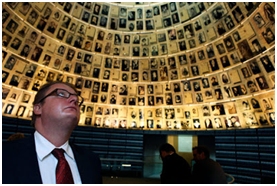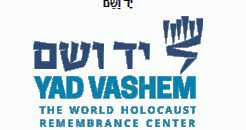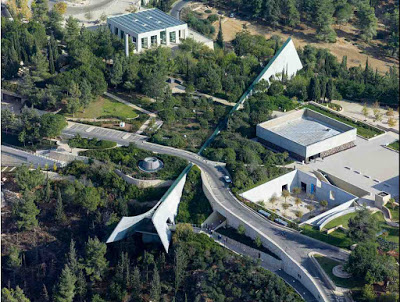Yad Vashem’s Loud Silence Amid Israel’s Deportations of Asylum Seekers
Yad Vashem, Israel’s Holocaust museum was established by law
in 1953. From the start it was intended to be integral to Israel’s propagandistic
use of the Holocaust in its war against the Palestinians and as justification for the State’s existence. Even the title
‘Martyrs’ and Heroes Remembrance (Yad Vashem) Law’ is evidence of a
determination to rewrite the history of the Holocaust from a Zionist perspective.
The Holocaust became Israel’s foundational myth.
in 1953. From the start it was intended to be integral to Israel’s propagandistic
use of the Holocaust in its war against the Palestinians and as justification for the State’s existence. Even the title
‘Martyrs’ and Heroes Remembrance (Yad Vashem) Law’ is evidence of a
determination to rewrite the history of the Holocaust from a Zionist perspective.
The Holocaust became Israel’s foundational myth.
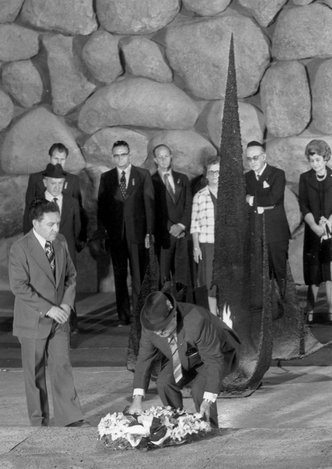 |
| John Vorster, Prime Minister of Apartheid South Africa, who was interned for Nazi sympathies in war, lays wreath to the Holocaust dead in Yad Vashem |
Those who
died were victims of fascism and genocidal racism. They were neither heroes nor
martyrs and they would not have seen themselves as such. They were innocents
who were murdered as a consequence of an ideology that became a material force of
its own, a state that was based on racial supremacy and a murderous
eugenics. To portray those who died as
martyrs and heroes in the battle for the Israeli state, which is what this law
says, is to co-opt the Holocaust dead posthumously into the Zionist movement. Given that Zionism was a minority movement in
every Jewish community in Europe, this is to show contempt and disdain for
those whose memories are being harnessed to a state which is based on the very
same principles that led to their murder.
died were victims of fascism and genocidal racism. They were neither heroes nor
martyrs and they would not have seen themselves as such. They were innocents
who were murdered as a consequence of an ideology that became a material force of
its own, a state that was based on racial supremacy and a murderous
eugenics. To portray those who died as
martyrs and heroes in the battle for the Israeli state, which is what this law
says, is to co-opt the Holocaust dead posthumously into the Zionist movement. Given that Zionism was a minority movement in
every Jewish community in Europe, this is to show contempt and disdain for
those whose memories are being harnessed to a state which is based on the very
same principles that led to their murder.
If anyone is
doubtful as to the above then they need only look at section 1.8 of the law
which stipulates that Yad Vashem should commemorate ‘the unceasing efforts of the besieged to reach Eretz Israel in spite of
all obstacles, and the devotion and heroism of their brothers who went forth to
liberate and rescue the survivors.’ This is called rewriting Holocaust history and
it is no different from those who deny the Holocaust outright. It is Zionism’s foundational Holocaust myth. It uses
the Holocaust as a weapon in the Zionist armoury.
doubtful as to the above then they need only look at section 1.8 of the law
which stipulates that Yad Vashem should commemorate ‘the unceasing efforts of the besieged to reach Eretz Israel in spite of
all obstacles, and the devotion and heroism of their brothers who went forth to
liberate and rescue the survivors.’ This is called rewriting Holocaust history and
it is no different from those who deny the Holocaust outright. It is Zionism’s foundational Holocaust myth. It uses
the Holocaust as a weapon in the Zionist armoury.
Those who
tried to escape from the Nazis tried to escape to any destination which would
have them. Palestine was neither the
first nor the only destination. Some 60,000
Jews out of a total of 446,000 Jews who escaped from the Reich territories between
May 1933 and December 31 1939 went to Palestine, i.e. less than one in seven.
[American Jewish Yearbook 1940-1] What the YV Law doesn’t say is that the Zionist
movement did all in its power, including lobbying the Gestapo, in order to
ensure that Jewish refugees only went to Palestine. [see for example Francis
Nicosia, Zionism and Anti-Semitism in Nazi Germany, p. 168]
tried to escape from the Nazis tried to escape to any destination which would
have them. Palestine was neither the
first nor the only destination. Some 60,000
Jews out of a total of 446,000 Jews who escaped from the Reich territories between
May 1933 and December 31 1939 went to Palestine, i.e. less than one in seven.
[American Jewish Yearbook 1940-1] What the YV Law doesn’t say is that the Zionist
movement did all in its power, including lobbying the Gestapo, in order to
ensure that Jewish refugees only went to Palestine. [see for example Francis
Nicosia, Zionism and Anti-Semitism in Nazi Germany, p. 168]
In
the words of Israeli historian and journalist Tom Segev, Yad Vashem is a ‘bizarre cult of memory, death and kitsch’.
[Segev, The Seventh Million, p.11] a ‘macabre worship of death.’ [Amos Elon,
The Israelis – Founders and Sons, p. 208]
the words of Israeli historian and journalist Tom Segev, Yad Vashem is a ‘bizarre cult of memory, death and kitsch’.
[Segev, The Seventh Million, p.11] a ‘macabre worship of death.’ [Amos Elon,
The Israelis – Founders and Sons, p. 208]
As Professor Idith Zertal of the Hebrew and
Bael Universities wrote in Israel’s Holocaust and the
Politics of Nationhood (p.100):
Bael Universities wrote in Israel’s Holocaust and the
Politics of Nationhood (p.100):
‘The
transference of the Holocaust situation on to the Middle East reality… not only
created a false sense of the imminent danger of mass destruction. It also immensely
distorted the image of the Holocaust, dwarfed the magnitude of the atrocities
committed by the Nazis, trivializing the unique agony of the victims and the
survivors, and utterly demonizing the Arabs and their leaders.’
transference of the Holocaust situation on to the Middle East reality… not only
created a false sense of the imminent danger of mass destruction. It also immensely
distorted the image of the Holocaust, dwarfed the magnitude of the atrocities
committed by the Nazis, trivializing the unique agony of the victims and the
survivors, and utterly demonizing the Arabs and their leaders.’
You might therefore think that the first
organisation in Israel to speak out against Netanyahu’s attempt to deport
40,000 Black Africa refugees to death and torture would be Yad Vashem. After all what is the point of Holocaust memorial
museum unless it seeks to draw conclusions about what happened during the Holocaust for humanity’s behaviour today? Perhaps the
most obvious of all lessons of the Holocaust was that if the Western countries,
in particular the United States, had open their doors, far fewer Jews would
have died.
organisation in Israel to speak out against Netanyahu’s attempt to deport
40,000 Black Africa refugees to death and torture would be Yad Vashem. After all what is the point of Holocaust memorial
museum unless it seeks to draw conclusions about what happened during the Holocaust for humanity’s behaviour today? Perhaps the
most obvious of all lessons of the Holocaust was that if the Western countries,
in particular the United States, had open their doors, far fewer Jews would
have died.
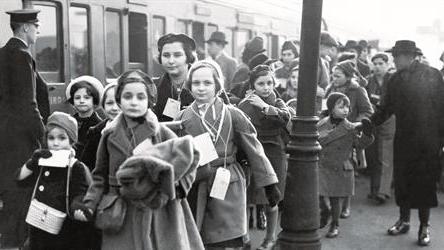 |
| The Kindertransport – 10,000 Jewish children from Germany, Austria and Czechoslovakia arrive in London – the Zionists opposed their entry |
Even as devoted an Israel apologist like Alan
Dershowitz in comments
to ILTV Daily agreed that “The
whiff of racism can’t be avoided when you have a situation where 40,000 people
of color are the ones who are being deported en masse, without being
individualized and every single case considered on its merits,”
Dershowitz in comments
to ILTV Daily agreed that “The
whiff of racism can’t be avoided when you have a situation where 40,000 people
of color are the ones who are being deported en masse, without being
individualized and every single case considered on its merits,”
Yet
Yad Vashem has remained silent. It has
refused to openly oppose Netanyahu’s racist plans. It has issued a few meal mouthed platitudes
whilst reminding people that the Holocaust must not be compared with anything,
in other words it has no lessons to draw from the genocide of the Jews.
Yad Vashem has remained silent. It has
refused to openly oppose Netanyahu’s racist plans. It has issued a few meal mouthed platitudes
whilst reminding people that the Holocaust must not be compared with anything,
in other words it has no lessons to draw from the genocide of the Jews.
Yad
Vashem is on the itinerary of all foreign dignitaries to Israel, including
fascists and neo-Nazis. In April 1976 Yad Vashem welcomed John Vorster, Prime
Minister of South Africa, who was interned during the war for Nazi sympathies. It has played host to a variety of far-Right and anti-Semitic politicians, from
Heinz Strache of Austria to Michal Kaminsky of Poland’s Law & Justice Party
and Robert Ziles of Latvia’s LNNK. Israel Shahak, a survivor of the Warsaw
Ghetto and Belsen-Bergen concentration camp wrote,
Vashem is on the itinerary of all foreign dignitaries to Israel, including
fascists and neo-Nazis. In April 1976 Yad Vashem welcomed John Vorster, Prime
Minister of South Africa, who was interned during the war for Nazi sympathies. It has played host to a variety of far-Right and anti-Semitic politicians, from
Heinz Strache of Austria to Michal Kaminsky of Poland’s Law & Justice Party
and Robert Ziles of Latvia’s LNNK. Israel Shahak, a survivor of the Warsaw
Ghetto and Belsen-Bergen concentration camp wrote,
Of the Yad Vashem… theatre, I do not wish to speak, at all. It, and its
vile exploiting, such as honouring South Africa collaborators with the Nazis
are truly beneath contempt.[Kol Hair, 19 May 1998, Jerusalem].
The real purpose of Holocaust awareness ‘is
not at an understanding of the past, but a manipulation of the future’.
[Boaz Evron, (1983) “Holocaust: The Uses of Disaster’, Radical America 17, No.
4]. No other group is allowed to claim a share of the “credit”. At the centre
of this manipulation stands Yad Vashem.
not at an understanding of the past, but a manipulation of the future’.
[Boaz Evron, (1983) “Holocaust: The Uses of Disaster’, Radical America 17, No.
4]. No other group is allowed to claim a share of the “credit”. At the centre
of this manipulation stands Yad Vashem.
Holocaust awareness and ‘the culture of
victimization’ allowed a Jewish victim identity to become dominant at the same
time as anti-Semitism was disappearing. [The Holocaust in American Life, Peter Novick, Houghton Mifflin, 1999, New York, p.190.
See Review: Deconstructing Holocaust Consciousness, Joseph Massad, JPS, Vol. 32
No. 1 p.82]. In
its place the ‘new anti-Semitism’ i.e. anti-Zionism emerged as a substitute.
victimization’ allowed a Jewish victim identity to become dominant at the same
time as anti-Semitism was disappearing. [The Holocaust in American Life, Peter Novick, Houghton Mifflin, 1999, New York, p.190.
See Review: Deconstructing Holocaust Consciousness, Joseph Massad, JPS, Vol. 32
No. 1 p.82]. In
its place the ‘new anti-Semitism’ i.e. anti-Zionism emerged as a substitute.
.
Even though Yad Vashem has rejected any comparison between the
distress of the refugees in Israel and persecuted Jews in Europe during the
Holocaust, they also found it appropriate to make a limp statement about asylum
seekers here
distress of the refugees in Israel and persecuted Jews in Europe during the
Holocaust, they also found it appropriate to make a limp statement about asylum
seekers here
Alon Harel, Uriel Procaccia Mar
08, 2018, Ha’aretz
08, 2018, Ha’aretz
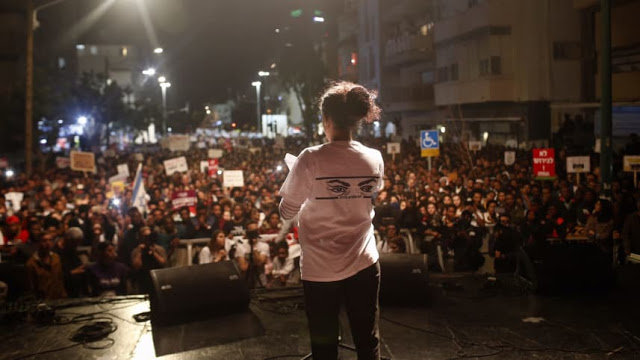 |
| FILE PHOTO: Asylum seekers protest against deportation in Tel Aviv, Israel, February 24, 2018.Meged Gozani |
On June 26,
1941, the German army entered Vilnius, accompanied by Reinhard Heydrich’s
Einsatzkommando killing squads, elite units of sorts that were in charge of
exterminating Jews, Roma Gypsies, homosexuals and Communists.
1941, the German army entered Vilnius, accompanied by Reinhard Heydrich’s
Einsatzkommando killing squads, elite units of sorts that were in charge of
exterminating Jews, Roma Gypsies, homosexuals and Communists.
The broad
range of those destined for extermination symbolized the Nazis’ commitment to
Aryan racial purity, in their readiness to rid themselves not only of the lower
strata of the human race but also of leftists and of those whose sexual
orientation didn’t find favor among high-ranking officials of the regime.
range of those destined for extermination symbolized the Nazis’ commitment to
Aryan racial purity, in their readiness to rid themselves not only of the lower
strata of the human race but also of leftists and of those whose sexual
orientation didn’t find favor among high-ranking officials of the regime.
Miron
Abeliovich, the grandfather of one of this piece’s two authors, Uriel, was
among those murdered, eliminated along with all of the other members of his
household in Vilnius, Lithuania.
Abeliovich, the grandfather of one of this piece’s two authors, Uriel, was
among those murdered, eliminated along with all of the other members of his
household in Vilnius, Lithuania.
Many members
of Alon’s family lived in the Free City of Danzig, whose conquest by the Nazis
served as a springboard for the Hitler regime’s goal of cleansing the city of
Catholic believers and more generally to subjugate the Slavic peoples to the
superior race. The murder of Alon’s family following the occupation of Danzig,
with the outbreak of World War II, was no more than a footnote in the
larger Nazi plan
for the city.
of Alon’s family lived in the Free City of Danzig, whose conquest by the Nazis
served as a springboard for the Hitler regime’s goal of cleansing the city of
Catholic believers and more generally to subjugate the Slavic peoples to the
superior race. The murder of Alon’s family following the occupation of Danzig,
with the outbreak of World War II, was no more than a footnote in the
larger Nazi plan
for the city.
Between 1939
and 1945, the United States gave asylum on its territory to only about 250,000
Jewish refugees, roughly a thousandth of the American population at the time.
Other Western countries were not more forthcoming. So, for example, when the
details regarding the anti-Semitic wave of destruction on Kristallnacht in
November 1938 became known, a plan was developed to allow for the settlement of
15,000 persecuted Jews in Australia over the course of three years, but the
gates of the country remained closed to any additional Jewish refugees. Those
refused admission to all of those countries remained in or returned to the
European inferno, and many of them were killed in the Holocaust.
and 1945, the United States gave asylum on its territory to only about 250,000
Jewish refugees, roughly a thousandth of the American population at the time.
Other Western countries were not more forthcoming. So, for example, when the
details regarding the anti-Semitic wave of destruction on Kristallnacht in
November 1938 became known, a plan was developed to allow for the settlement of
15,000 persecuted Jews in Australia over the course of three years, but the
gates of the country remained closed to any additional Jewish refugees. Those
refused admission to all of those countries remained in or returned to the
European inferno, and many of them were killed in the Holocaust.
The above
paragraphs describe episodes of Holocaust history that are seemingly unrelated
to each other, but there is a common thread that runs through them. The first
few paragraphs demonstrate the obvious, that human evil can be directed not
only against our own people but against anyone whom the regime wishes to
deprive of their rights. The fifth paragraph, regarding restrictions on
immigration at the time, show that the evil and cruelty of passive actors
sometimes are no better than those of active players.
paragraphs describe episodes of Holocaust history that are seemingly unrelated
to each other, but there is a common thread that runs through them. The first
few paragraphs demonstrate the obvious, that human evil can be directed not
only against our own people but against anyone whom the regime wishes to
deprive of their rights. The fifth paragraph, regarding restrictions on
immigration at the time, show that the evil and cruelty of passive actors
sometimes are no better than those of active players.
Yad Vashem, the World Holocaust
Remembrance Center in Jerusalem, the central institution entrusted with the
sacred memory of the Holocaust and the lessons that should be forever drawn
from it, acknowledges some of these lessons on its website.
Remembrance Center in Jerusalem, the central institution entrusted with the
sacred memory of the Holocaust and the lessons that should be forever drawn
from it, acknowledges some of these lessons on its website.
In its
section on the Righteous Among the Nations, non-Jews who saved Jews during the
Holocaust, Yad Vashem quotes the moving remarks of Elie Wiesel,
who wrote, “Let us remember: What hurts
the victim most is not the cruelty of the oppressor but the silence of the
bystander. Let us not forget, after all, there is always a moment when moral
choice is made. And so we must remember these good people who helped Jews
during the Holocaust.”
section on the Righteous Among the Nations, non-Jews who saved Jews during the
Holocaust, Yad Vashem quotes the moving remarks of Elie Wiesel,
who wrote, “Let us remember: What hurts
the victim most is not the cruelty of the oppressor but the silence of the
bystander. Let us not forget, after all, there is always a moment when moral
choice is made. And so we must remember these good people who helped Jews
during the Holocaust.”
And yet,
when we face a similar reality of asylum seekers in
Israel who are begging for their lives and, who, based on most accounts, can
expect torture, theft, rape and even death in the countries where they are due
to be sent, Yad Vashem
issued a statement declaring that it is inappropriate and
dangerous to compare the situation of the Jews during the Holocaust with
Israel’s policy regarding those seeking residency status in the country now.
when we face a similar reality of asylum seekers in
Israel who are begging for their lives and, who, based on most accounts, can
expect torture, theft, rape and even death in the countries where they are due
to be sent, Yad Vashem
issued a statement declaring that it is inappropriate and
dangerous to compare the situation of the Jews during the Holocaust with
Israel’s policy regarding those seeking residency status in the country now.
Indeed, how
can they be compared? During the Holocaust, those being persecuted were our own
people, whereas at the present time, they are only those of African background
“seeking residency.”
can they be compared? During the Holocaust, those being persecuted were our own
people, whereas at the present time, they are only those of African background
“seeking residency.”
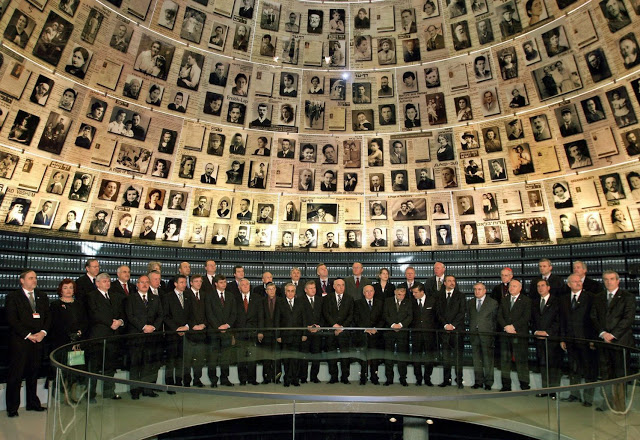 |
| FILE PHOTO: World leaders gather in the Hall of Names in Yad Vashem in Jerusalem, March 16, 2005.AP |
During the
Holocaust, the gates of Switzerland, Britain and other countries were shut,
while now it is the gates of our own country. But despite the fact that the
leaders of Yad Vashem have rejected any comparison between the distress of the
refugees in Israel and persecuted Jews in Europe during the Holocaust, they
also found it appropriate to make a limp statement about asylum seekers here,
saying that their situation involves a “national
and international challenge that requires empathy, compassion and mercy.”
Holocaust, the gates of Switzerland, Britain and other countries were shut,
while now it is the gates of our own country. But despite the fact that the
leaders of Yad Vashem have rejected any comparison between the distress of the
refugees in Israel and persecuted Jews in Europe during the Holocaust, they
also found it appropriate to make a limp statement about asylum seekers here,
saying that their situation involves a “national
and international challenge that requires empathy, compassion and mercy.”
“The experience of the Jewish people over
generations heightens this obligation,” the statement continued. “The authorities in Israel must make every
effort so that there is no person who arrived in Israel with a sword over his
neck that did not receive refugee status.”
generations heightens this obligation,” the statement continued. “The authorities in Israel must make every
effort so that there is no person who arrived in Israel with a sword over his
neck that did not receive refugee status.”
More than a
month ago, while the controversy was seething, we approached the administration
of Yad Vashem and asked for an interpretation and clarification regarding the
call for “compassion.”
month ago, while the controversy was seething, we approached the administration
of Yad Vashem and asked for an interpretation and clarification regarding the
call for “compassion.”
We asked
what the leaders of the institution believed was or was not possible to do in
the concrete case of asylum seekers at the present time.
what the leaders of the institution believed was or was not possible to do in
the concrete case of asylum seekers at the present time.
We also
asked what Yad Vashem’s position was regarding the masses of
asylum seekers, which is nearly all of them, who have not
received refugee status.
asked what Yad Vashem’s position was regarding the masses of
asylum seekers, which is nearly all of them, who have not
received refugee status.
Does Yad
Vashem believe that they should be given such status? Is it prepared not to be
“a bystander” in the face of the government’s policy not to grant refugee
status to almost any of these large numbers of persecuted people?
Vashem believe that they should be given such status? Is it prepared not to be
“a bystander” in the face of the government’s policy not to grant refugee
status to almost any of these large numbers of persecuted people?
We have
implored Yad Vashem to fulfill its moral and historic mission and to raise a
hue and cry that the honorable interior minister would have difficulty
ignoring. It is in fact easy for Prime Minister Benjamin Netanyahu’s
government to ignore demands for justice from those whom it deems “Jew haters,”
and it probably even derives sweet pleasure from that as well.
implored Yad Vashem to fulfill its moral and historic mission and to raise a
hue and cry that the honorable interior minister would have difficulty
ignoring. It is in fact easy for Prime Minister Benjamin Netanyahu’s
government to ignore demands for justice from those whom it deems “Jew haters,”
and it probably even derives sweet pleasure from that as well.
On the other
hand, ignoring a strong demand by an institution that is a symbol of the
catastrophe that befell our people and that also has, it must be admitted,
material value in our relations with the nations of the world, is much more
difficult.
hand, ignoring a strong demand by an institution that is a symbol of the
catastrophe that befell our people and that also has, it must be admitted,
material value in our relations with the nations of the world, is much more
difficult.
We have
warned the good people at Yad Vashem, who drag every dignitary to visit the
institution, who rub shoulders with them and curry their sympathies. And we
have explained that if Yad Vashem refrains from dealing with this urgent issue,
it could, in one fell swoop, lose its legitimacy as a universal moral beacon
and instead be perceived in the eyes of the world as an ethnocentric faction
whose only interest is the Jewish people and its ability to engender feelings
of guilt among non-Jews.
warned the good people at Yad Vashem, who drag every dignitary to visit the
institution, who rub shoulders with them and curry their sympathies. And we
have explained that if Yad Vashem refrains from dealing with this urgent issue,
it could, in one fell swoop, lose its legitimacy as a universal moral beacon
and instead be perceived in the eyes of the world as an ethnocentric faction
whose only interest is the Jewish people and its ability to engender feelings
of guilt among non-Jews.
To date, we
have not managed to obtain a response to our inquiry.
have not managed to obtain a response to our inquiry.
Alon Harel is a professor of law at the Hebrew University of Jerusalem,
and Uriel Procaccia a professor of law at Tel Aviv University.
and Uriel Procaccia a professor of law at Tel Aviv University.
Posted in Blog
